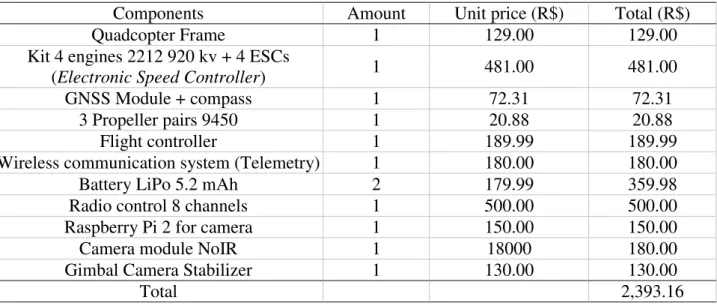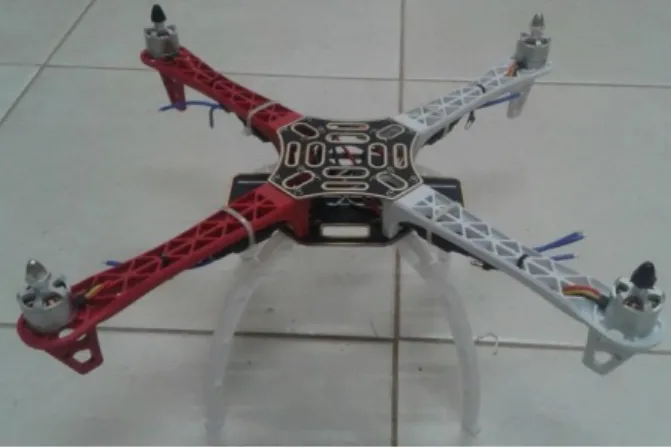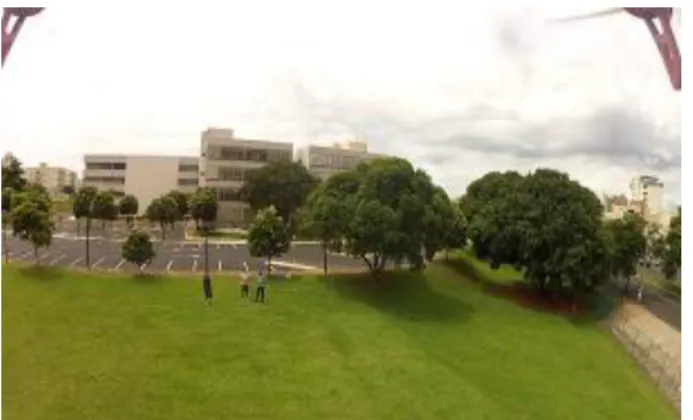Engineering ISSN: 1809-4430 (on-line)
_________________________
2 Universidade Federal de Uberlândia/ Uberlândia - MG, Brasil.
TECHNICAL PAPER
ASSEMBLY OF A REMOTELY PILOTED AIRCRAFT OF LOW COST APPLIED TO AGRICULTURE
Doi:http://dx.doi.org/10.1590/1809-4430-Eng.Agric.v37n6p1268-1274/2017
JOÃO P. A. R. DA CUNHA1*, MATHEUS A. SIRQUEIRA NETO2
1*Corresponding author. Universidade Federal de Uberlândia/ Uberlândia - MG, Brasil. E-mail: jpcunha@ufu.br
ABSTRACT: The remotely piloted aircraft (RPA) have great applicability in agriculture. Although it is a technology that has been developed for many years, in the field of agriculture it passed unnoticed for a long time. The high cost of acquisition is still a limiting factor for small and medium-sized farmers. In this way, this study had as objective to develop a low cost RPA for agriculture application. In the present study, the development and the assembly of an RPA prototype of a quadcopter type is presented, consisting of four engines and of vertical propulsion, capable of moving without human intervention, that is, autonomous flight, applied to agriculture and low cost investment. In it was boarded a data control and processing system collected from sensors and cameras, using hardware and software from a free platform (Open Source). The assembly equipment showed to be robust, with a payload of approximately 1,000 grams, with an acquisition cost (R$ 2,393.16), included the camera module, much lower than those commercially available and suitable for the agricultural application, as acquisition, processing and interpretation of digital images, due to the quality of the images obtained.
KEYWORDS: precision agriculture, quadcopters, RPA.
INTRODUCTION
The agriculture is increasingly linked to technology of information and automation. In this context, a tool with many applications is the remotely piloted aircraft (RPA) (Gómez-Candón et al.; 2014; Torres-Sánchez et al., 2013). It is an air vehicle, capable of flying in the atmosphere, outside the of the ground effect, which was designed or modified to not receive a human pilot and is operated by remote control or autonomous. The RPAs had their initial project intended to military use, however due to the popularity that has occurred, the technology has spread and gained space among civilians. The first reports of RPAs in Brazil occurred in the 1980s, but only in recent years has there been an increase in the interest in their use (Jorge & Inamasu, 2014). Colomina & Molina (2014) present a detailed history of the evolution of RPAs worldwide.
An RPA consists not only of the aircraft, but also of the ground control, and is through it that is possible to accomplish the field flight planning and remotely monitor the flight performance, receiving information such as altitude, vertical displacement speed, distance from the take-off point, among other information. The essential electronic components are the GNSS system, compass, gyroscope, accelerometer, barometer, magnetometer and IMU (Inertial Measurement Unit), which has the function of ensuring the best accuracy positioning during flight, once that the GNSS system expresses a greater margin of error (Jorge & Inamasu, 2014; Xiang & Tian, 2011).
Although it is a technology that has been developed for many years, in the agricultural scope passed unnoticed for a long time (Ballesteros et al., 2014); it has been talked about RPA applied to agriculture in the last decade, but it is still a technology with a high initial cost, noticing the large farmers who allocate part of their resource to the implantation of technologies in the property.
The high cost, therefore, is a limiting factor for the use by small and medium producers (Zhang & Kovacs, 2012), who can greatly benefit from the technology, such as: crop inspection, weed detection (Peña et al., 2013), identification of planting failures, target volumetry, vegetation indices calculation, detection of plant health in cultivated areas, among others.
In this sense, it is believed that it is possible to develop a low-cost RPA from isolated components available in the market, in order to enable small farmers to use it to obtain digital images of their property, with the view to optimize their production.
In this way, this study had as objective to develop an inexpensive unmanned aerial vehicle for application in the agriculture.
DESCRIPTION OF THE SUBJECT
There are already several RPA models available in the market; however, high cost is a possible limiting factor for acquisition. In this sense, the strategy was to design the prototype from individual components of low cost, in order to allow interested users to build their own equipment.
For the development of the RPA, the following steps were followed: choice of the airplane model (fixed or rotating wings); design of the structure, as well as the composition of the constituent material; selection and acquisition of the essential parts for the flight, aiming at the low cost; physical assembly of the RPA and calibration of the electronic components.
Among the different types of RPAs, it was decided to choose a multi-rotor model (rotating wings), due to the easiness of landing and takeoff, greater tolerance to strong winds and lower cost (Silva & Morais, 2014).
The selection of the components for the assembly of the RPA was performed aiming to have the lowest possible cost, maintaining the final operational performance. Table 1 shows the components and the investment required to set up the low cost RPA able to perform activities focused on the agricultural scope.
TABLE 1. Cost of basic components of RPA.
Components Amount Unit price (R$) Total (R$)
Quadcopter Frame 1 129.00 129.00
Kit 4 engines 2212 920 kv + 4 ESCs
(Electronic Speed Controller) 1 481.00 481.00
GNSS Module + compass 1 72.31 72.31
3 Propeller pairs 9450 1 20.88 20.88
Flight controller 1 189.99 189.99
Wireless communication system (Telemetry) 1 180.00 180.00
Battery LiPo 5.2 mAh 2 179.99 359.98
Radio control 8 channels 1 500.00 500.00
Raspberry Pi 2 for camera 1 150.00 150.00
Camera module NoIR 1 18000 180.00
Gimbal Camera Stabilizer 1 130.00 130.00
Total 2,393.16
Assembly
The central structure of the RPA has a printed circuit board to facilitate the connections to the parts that require power for operation. In this board, were welded, respecting the polarities of the pins, the ESCs (Electronic Speed Controller), which are responsible for the rotation of the electric motors of the RPA, as well as the welding of the power input connector, where the battery is connected to the circuit board. Figure 1 shows the central structure of the RPA.
In order to increase the autonomy of flight, it was decided to use the brushless motor 2212 of 920 kv, this made possible to increase the weight on the RPA and, with that, was able to connect batteries with greater autonomy. Usually motors of 1000 to 1200 kv are used for this type of RPA. The kv is a measure that represents how many rotations per minute (RPM) an engine is able to rotate for each Volt (unit of energy) applied.
FIGURE 1. Central RPA structure.
Figure 2 shows the attachment of the engines to the RPA arms. The ESCs were then fixed to the RPA arms using plastic clamps and the ESCs were then connected to the engine. It is able to control the speed of the engine rotation by varying the frequency of the currents between its phases. Its selection was made from the maximum current of the engines.
FIGURA 2. Fixation of the RPA arm to the central structure.
FIGURE 3. RPA assembly structure, ready to receive the sensors.
The electric RPAs have high energy requirements to power the engines and also the entire mounted system, such as: flight control system and sensors, aerial image acquisition system and others. The battery used is composed of three cells, a load of 5200 mAh, and can supply up to 10 times its load, as it has the discharge value of 10 C. It is possible to reach a current of 52 amps without damaging the battery. In order to increase the autonomy, it was decided to connect two 5200 mAh batteries in parallel to the circuit of the central board of the RPA.
The flight controller used was the ArduCopter v2.6 which is an advanced autopilot system. Its platform is of open source, and allows the user to transform RPAs from fixed or rotating wings and vehicles such as cars and boats into fully autonomous vehicles; with the ability to perform flight missions through the previously programmed GNSS system at the ground workstation. The version 2.6 does not include a compass on board, so there is a need for a GNSS with compass in the same module. It is important to emphasize where the GNSS module will be fixed to the aircraft board, since the components are susceptible to electromagnetic interference, so location was avoided near noise sources such as the ESCs, the flight control board and the batteries. Ideally, we should have a fixing rod.
Communication with the RPA during the flight may occur through the telemetry system (commonly used during autonomous flights) or by the radio control system (responsible for transmitting the command signal: up, down, left and right shift and rotate in the own axis). There are telemetries with a range of 3 km with a clear and unobstructed position between the transmitter and the receiver and also long range, reaching 40 km or more from the take-off coordinate. In this project, telemetry with a range of approximately 3 km was used, considered in clear conditions and without obstacles. The control radio has a range of approximately 3 km in clear and unobstructed conditions between the transmitter and the receiver. Both systems are safe, and normally operate at 433 MHz and 2.4 GHz, respectively, the last has a frequency that is less susceptible to interference from electromagnetic waves dispersed in the atmosphere.
Several digital photogrammetric sensors have led to an increase in the possibility of using RPAs, especially when applied in agriculture scope. It was used an infrared camera module add-on designed for Raspberry Pi with an 8-megapixel Sony IMX219 sensor. Static images come up to 3280 x 2464 pixels and support videos 1080p80, 720p60 and 640 x 480p60/90. The camera module weighs approximately 3.4 grams and communication with the Raspberry Pi board is done through
flat cables via serial interface. In order to mount the camera to the RPA, a stabilizer with the IMU sensor was necessary, it always keeps the camera in the horizontal position regardless of the movement or vibration of the RPA, reducing distortions in the images and increasing the accuracy. This equipment is called Gimbal (can be composed of 2 or 3 axes) and is easily found on
e-commerce sites.
Mission Planner software. For safety reasons, the entire assembly stage, set up and bench tests of the PRA must be performed without placing the propellers in the motors.
FIGURE 4. Final assembly of the RPA.
After making the necessary connections, it started the communication of the flight controller with the computer systems and calibration of the sensors.
Communication of the flight controller with computational tools
After the completion of the development of the RPA, specifically the structural part began the stage of communication of the RPA with the computational systems. Figure 5 shows the open source computer program available for download on the internet for free; it was decided to use the
Mission Planner, due to the flight controller be easily connected to the platform. This feature makes
it possible to execute the flight configurations, calibration of the sensors, radio and telemetry system and engines, as well as monitor the route that was pre-established before take-off, among others.
FIGURE 5. Example of soil control system.
Through the Mission Planner program, the controller was programmed and the firmware was installed, which consist of a set of programmed instructions that are loaded on the controller chip, being responsible for internal operations such as: sensor reading, power engines, GNSS system and others.
source program, with the possibility of being able to be adjusted to show flight control variables and
sensors according to the user’s interest.
It was possible to carry out an engine drive test, as well as, calibration of the rotation. The communication between the ground control station and the flight controller was established and the results of the telemetry data were as expected. Figure 6 shows aerial photography during the test flight to analyze the performance of the RPA. The results achieved were quite promising.
FIGURE 6. Aerial photo of test flight.
In terms of safety, the prototype was considered adequate, because it has an internal system of
fail-safe, in which parameters pre-established by the operator, before starting the mission, regarding
the level of use of the battery, allow to activate the safety mode, and the RPA automatically takes the RTL (return to land) flight mode and makes the landing in complete safety. Another positive point observed is that the central structure of the RPA counts with a printed circuit board, avoiding that short-circuit and system failure occur in operation due to lack of energy, causing the RPA to fall.
CONCLUSIONS
Based on electronic components in the market, a low-cost RPA (R$ 2,393.16) of the multi-rotor type (rotating wings) was developed, with the camera module already coupled, and with characteristics suitable for agricultural use. The images obtained were of high stability due to the camera stabilization system and georeferenced, which allowed the orthorectification and orthophotos mosaics generation. The equipment proved to be robust, easy to use and with good flight stability, as well as very safe.
REFERENCES
Ballesteros R, Ortega JF, Hernández D, Moreno MA (2014) Applications of georeferenced high-resolution images obtained with unmanned aerial vehicles. Part I: Description of image acquisition and processing. Precision Agriculture 15(6):579-592.
Colomina I, Molina P (2014) Unmanned aerial systems for photogrammetry and remote sensing: a review. ISPRS Journal of Photogrammetry and Remote Sensing 92(1):79-97.
Gómez-Candón D, Castro AI, López-Granados FL (2014) Assessing the accuracy of mosaics from unmanned aerial vehicle (UAV) imagery for precision agriculture purposes in wheat. Precision Agriculture 15(1):44-56.
Peña JM, Torres-Sánchez J, Castro AI, Kelly M, López-Granados F (2013) Weed mapping in early-season maize fields using object-based analysis of unmanned aerial vehicle (UAV) images. Plos One 8(10):e77151.
Silva KL, Morais AS (2014) Hardware para controle avançado de veículo aéreo não tripulado do tipo quadricóptero. Horizonte Científico 8(1):1-22.
Torres-Sánchez J, López-Granados F, Castro AI, Peña-Barragán JM (2013) Configuration and specifications of an unmanned aerial vehicle (uav) for early site specific weed management. Plos One 8(3):e58210.
Xiang H, Tian L (2011) Development of a low-cost agricultural remote sensing system based on an autonomous unmanned aerial vehicle (UAV). Biosystems Engineering 108(2):174-190.




